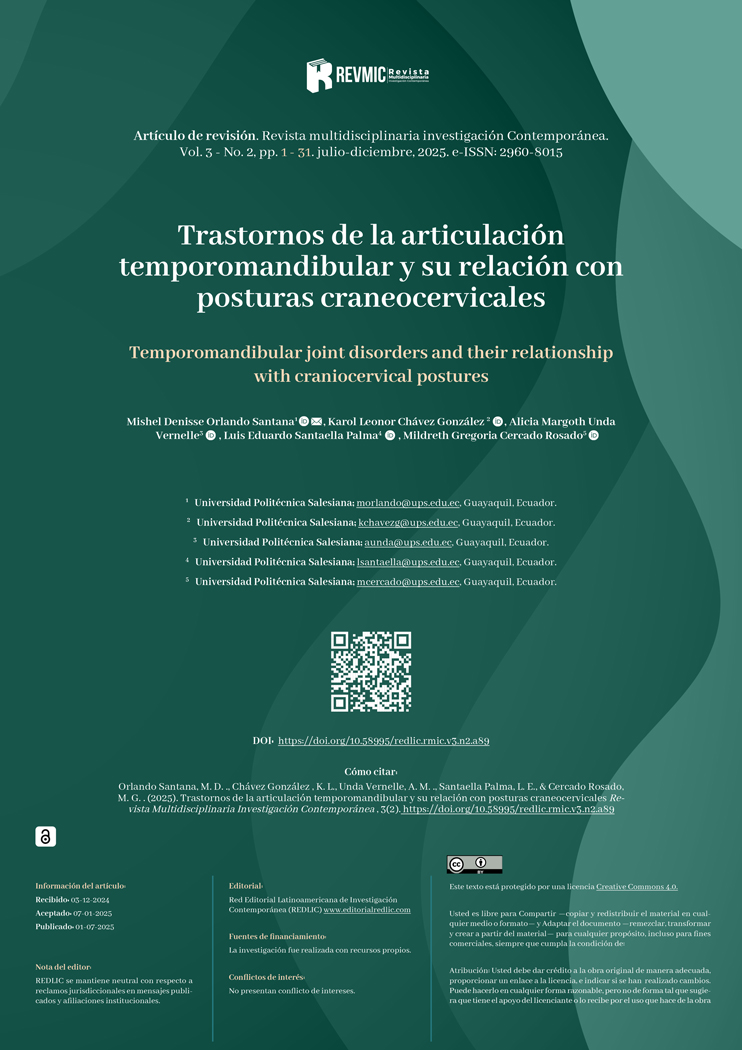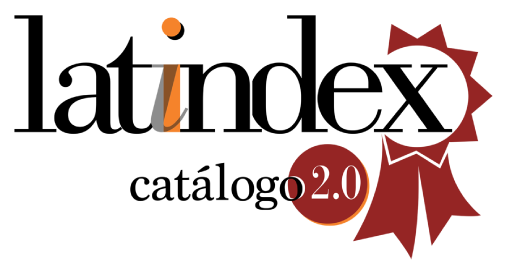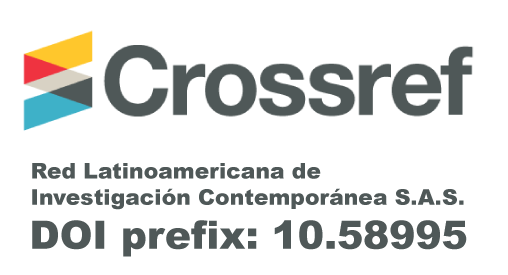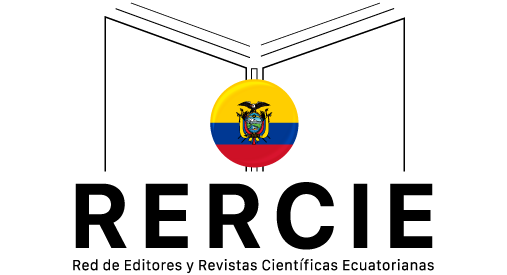Trastornos de la articulación temporomandibular y su relación con posturas craneocervicales
Resumen
Introduction: The temporomandibular joint is a bilateral synovial joint between the mandibular condyle and the mandibular fossa of the temporal bone. Objective: The objective of this research is to analyze the association between temporomandibular joint disorders and alterations in craniocervical postures. Methodology: A narrative review was carried out. The information was collected in the databases: Scopus, PubMed, Web of Science, Google Scholar, during August 2024 to November 2024. Conclusions: The posture in which the head is located influences the position of the cervical spine and an alteration in this can cause problems in dental occlusion. Among the abnormal cervical postures, the following postures stand out: kyphotic, lordotic and flattened. Craniocervical dysfunction is an anomaly in which the head is positioned forward with respect to the axial axis of the body and is usually associated with the appearance of temporomandibular disorders.
Descargas
Referencias
- Sang, S., Ameli, N., Almeida, F. T., & Friesen, R. (2024). Association between clinical symptoms and MRI image findings in symptomatic temporomandibular joint (TMJ) disease: A systematic review. Journal of Cranio-Maxillofacial Surgery. 53(7):835-42. https://doi.org/10.1016/j.jcms.2024.04.006 DOI: https://doi.org/10.1016/j.jcms.2024.04.006
- Connelly, S. T., Tartaglia, G. M., & Silva, R. G. (2019). Contemporary Management of Temporomandibular Disorders. Springer Nature Switzerland AG. DOI: https://doi.org/10.1007/978-3-319-99909-8
- Pope, T., Bloem, H., Beltran, J., Morrison, W., Wilson, D. (2023). Musculoskeletal Imaging. Springer Nature Switzerland AG.
- Blakley, B. W., & Blakley, J. E. (2023). Functional Illness of the Head and Neck. Springer Nature Switzerland AG DOI: https://doi.org/10.1007/978-3-031-12998-8
- Restrepo, C. C., Quintero, Y., Tamayo, M., & Tamayo, V. (2008). Efecto de la posición craneocervical en las funciones orales fisiológicas. CES Odontología, 21(1), 71-75. https://revistas.ces.edu.co/index.php/odontologia/article/view/55/45
- Vargas, M. (2012). Anatomía y exploración física de la columna cervical y torácica. Medicina Legal de Costa Rica, 29(2), 77-92. https://www.scielo.sa.cr/scielo.php?script=sci_arttext&pid=S1409-00152012000200009
- Sgarbi, T. (2018). Unión cráneo-cervical – anatomía normal ycorrelación con imágenes. Revista Argentina de Radiologìa, 82(4), 161-167. https://doi.org/10.1055/s-0038-1656541 DOI: https://doi.org/10.1055/s-0038-1656541
- Aguilar et al. (2024). Recursos imagenológicos para el diagnóstico y seguimiento de las alteraciones del paciente con disfunción del sistema cráneo-cérvico mandibular. Reporte Imagenol Dentomaxilofacial, 3(1): e2024030102-e2024030102.. https://doi.org/10.60094/RID.20240301-32 DOI: https://doi.org/10.60094/RID.20240301-32
- Ramírez, M., Rodulfo, E., Urgilés, C., Herrera, K., Ludizaca, D. (2021). Asociación entre postura cráneo cervical y maloclusiones. Revista KIRU, 18(1), 55-64. https://doi.org/10.24265/kiru.2021.v18n1.08 DOI: https://doi.org/10.24265/kiru.2021.v18n1.08
- García, A. (2020). Modelo Físico Biomecánico de cráneo y raquis cervical apto para estudio de movimientos y fuerzas musculares. Trabajo de Titulación, Universidad Politécnica de Madrid. Obtenido de https://oa.upm.es/66087/1/TFG_ALEJANDRO_DE_SANTIAGO_GARCIA_VALDECASAS.pdf
- León, Y., Cabrera, M., Guiracocha, E. (2024). Relación entre posición de las vértebras cervicales y la maloclusión clase II. Revisión de la literatura. Anatomía Digital, 7(1.3), 112-131. https://doi.org/10.33262/anatomiadigital.v7i1.3.3008 DOI: https://doi.org/10.33262/anatomiadigital.v7i1.3.3008
- Van den Wyngaert,T. (2023). Clinical Atlas of Bone SPECT/CT. Springer Nature Switzerland. DOI: https://doi.org/10.1007/978-3-031-26449-8
- Dimitroulis, G. (2024). The rationale for temporomandibular joint surgery: A review based on a TMJ surgical classification. Journal of Oral and Maxillofacial Surgery, Medicine, and Pathology, 36(4), 433-437. https://doi.org/10.1016/j.ajoms.2023.10.012 DOI: https://doi.org/10.1016/j.ajoms.2023.10.012
- Elledge, R. (2024). Classifications for the temporomandibular joint (TMJ): A systematic review of the literature. Journal of Cranio-Maxillo-Facial Surgery, 52:890–894. https://doi.org/10.1016/j.jcms.2024.04.010 DOI: https://doi.org/10.1016/j.jcms.2024.04.010
- Andrade, G. (2016). La postura humana y su reeducación. Revista Cubana de Medicina Física y Rehabilitación;8(2):231-240. https://www.medigraphic.com/pdfs/revcubmedfisreah/cfr-2016/cfr162h.pdf
- Pesantes, J., (2021). Asciación entre la postura craneocervical y los trastornos temporomandibulares. Una revisión de la literatura. Trabajo de grado. Universidad de Católica. https://dspace.ucacue.edu.ec/handle/ucacue/11286
- Kendall, F. P., Mac Creary, E. K., & Provance, P. G. (2007). Músculos: pruebas funcionales, postura y dolor. Marbán.
- Oliveira, C., Navarro, R., Ruiz, J. A., Brito, E. (2007). Biomecánica de la columna vertebral. https://accedacris.ulpgc.es/bitstream/10553/5983/1/0514198_00012_0005.pdf
- Limaylla, R. (2018).Transtornos temporomandibulares y alteraciones postulares de la columna cervical. Odontología Sanmarquina, 11(2): 66-69. https://doi.org/10.15381/os.v11i2.3027 DOI: https://doi.org/10.15381/os.v11i2.3027
- Bautista, Aida., Sánchez, F., Pérez, Andrés., Ambrosio, E. (2022). Asociación entre disfunción cráneocervical y trastornos temporomandibulares en adultos jóvenes. Revista Estomatológica Herediana, 32(2), 129-135. https://dx.doi.org/10.20453/reh.v32i2.4208 DOI: https://doi.org/10.20453/reh.v32i2.4211
- Tomás J, Castillo C, Villarroel G, Giner A &Felipe N. (2022) Efecto del síndrome de cabeza adelantada en el desarrollo de trastornos temporomandibulares. Rev Cient Odontol (Lima), 10(4): e133. https://doi.org/10.21142/2523-2754-1004-2022-133 DOI: https://doi.org/10.21142/2523-2754-1004-2022-133
- Villalón P, Frugone R, Palomino H. (2004). Algunas Mediciones Radiográficas Cráneo - Cervicales según Biotipo de Ricketts. Revista dental de Chile. ; 95(3): 11-17. https://dialnet.unirioja.es/servlet/articulo?codigo=9384483

Publicado 2025-07-01
Palabras clave
- epidemiología,
- odontología,
- rehabilitación,
- salud,
- trastornos
- articulación temporomandibular,
- posturas craneocervicales ...Más
Número
Sección
Derechos de autor 2025 Los autores que publiquen en la revista Multidisciplinaria Investigación Contemporánea aceptan los siguientes términos: 1. Los autores mantienen sus derechos de autor (copyright) y otorgan a la revista Multidisciplinaria Investigación Contemporánea el derecho de la primera publicación de su trabajo, bajo una licencia Creative Commons Attribution 4.0. Esta licencia permite que terceros utilicen el contenido publicado, siempre que se mencione la autoría y la primera publicación en esta revista. 2. Los autores pueden establecer acuerdos adicionales para la distribución no exclusiva de la versión publicada de su artículo en otros lugares, como repositorios institucionales, siempre y cuando se indique claramente que el trabajo fue publicado por primera vez en esta revista. 3. Los autores conservan sus derechos de autor (copyright) y garantizan a la revista Multidisciplinaria Investigación Contemporánea el derecho a publicar el manuscrito a través de los canales que considere apropiados. 4. Se permite y se recomienda a los autores compartir su trabajo en línea (por ejemplo, en repositorios institucionales o páginas web personales), una vez que el manuscrito haya sido aceptado para su publicación. Esto puede conducir a intercambios productivos y a una mayor y más rápida citación del trabajo publicado.

Esta obra está bajo una licencia internacional Creative Commons Atribución 4.0.



















